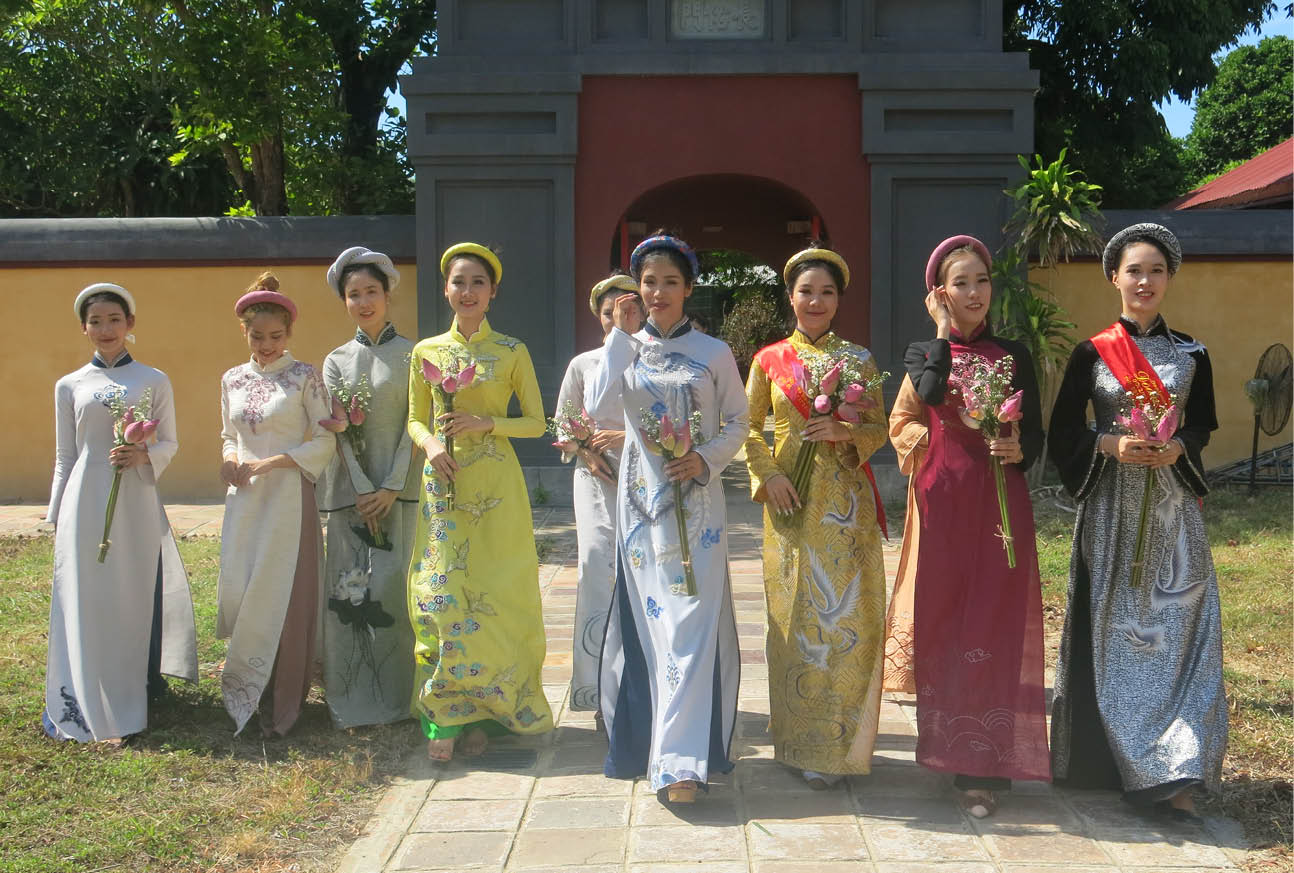
The young generation becomes more interested in traditional ao dai.
Wearing ao dai has been widespread
Ms. Vo Thi Quynh, a former teacher of Literature at Quoc Hoc High School for the Gifted, has been wearing ao dai for decades, not only at work but also at events, parties and ceremonies. She said she was happy to see many women wearing ao dai now, while she seemed to be the only to wear it before.
In a discussion about ao dai at Hue Museum of Culture, Ms. Nguyen Khoa Dieu Huyen, former headmistress of Hai Ba Trung High School, said: “Our generation was so familiar with ao dai. It was the image of high school girls wearing white ao dai on the way to school, the women in colorful ao dai, and the busy saleswomen in ao dai going to and fro. That’s why Hue was once nicknamed as ‘the city of ao dai’ by the journalists and foreign visitors. I wish that Hue women would wear ao dai everywhere.”
Her dream is about to come true when more and more people are wearing ao dai. The image of ao dai waving in the breeze is impressively beautiful to many visitors.
The designer Doan Trang, Director of Doan Trang Garment and Embroidery, believed that Hue would become more beautiful if Hue women voluntarily wear ao dai when they are out. If ao dai is seen everywhere in this city, visitors will have strong impression.
The initial steps towards the change in the dressing habit has been marked with the regulation governing that female employees and high school girls wear ao dai on Mondays, and that women in ao dai will be granted a free-of-charge visit to the Monuments of Hue on Vietnamese Women’s Day (October 20) and International Women’s Day (March 8). This change has made a beauty in daily life of the ancient city.
According to Doan Trang, her friends used to have many ao dai made but they hardly found an occasion to wear them because they felt that they were lost among others. Recently, the habit of wearing ao dai has been widespread now, and she has more clients than ever.
The ao dai for men has also been restored and worn. The elegant ao ngu than (‘five-paneled aristocratic gown’) has been worn more and more at the diplomatic and cultural events, ceremonies and conferences. The Provincial Department of Culture and Sports was the pioneer organization to have ao ngu than made for 30 male employees.
Actions speak louder than words
At the conference ‘Hue – The capital of ao dai Vietnam’ organized by the Department of Culture and Sports in early July, the Chairman of Provincial People’s Committee Phan Ngoc Tho confirmed that ao dai should regain its place in Hue life through practical activities. These include the gratitude ceremony to Lord Nguyen Phuc Khoat on the 25th of lunar May so that designers, tailors and models commemorate the creator of Vietnamese ao dai, and the annual ao dai festival in which all Hue people wear ao dai.
All employees at Hue Monuments Conservation Center wear traditional ao dai at work at the request of the People’s Committee. Together with encouraging female teacher to wear ao dai all week and high school girls three days a week, the provincial authorities have a policy to weave the entrance fee for visitors to the Citadel if they wear ao dai. There will be a gorgeous image if all is in ao dai. The Chairman, who wears ao dai in all receptions of ambassadors, has been an exemplar.
Researcher Nguyen Xuan Hoa opined that we should be practical in our views because life has considerably changed. It would be hard to see ao dai in every house, street, village, market and rice field as it was in the old days. However, the unique cultural value ao dai must be confirmed in order to establish a brand name ‘Ao dai Hue’ as a creative intellectual property of the ancient capital.
He also added that the provincial authorities should have activities to promote the beauty of the ao dai of Hue, in addition to encouraging local women wear ao dai in their social activities. Thua Thien Hue should pioneer in the campaign for the restoration of national costumes for both men and women.
Dr. Thai Kim Lan was optimistic that there would be a return of ao dai when there was an ao dai wearing trend. She said: “Why did the people yesterday wear ao dai when Lord Nguyen Phuc Khoat made it public? It’s because there was a rule for wearing it. I put forward the idea of Mr. Chairman of the People’s Committee, Phan Ngoc Tho, to encourage female employees, teachers and students to wear ao dai at least once a week.”
Dr. Phan Thanh Hai, Director of the Department of Culture and Sports, proposed that people’s council deputies should wear traditional ao dai in their meetings. He also asked the People’s Committee to urge the provincial organizations and agencies to make ao dai as their uniform for both men and women. It is certainly hard to ask everyone, especially men, to wear ao dai at first. But once the obstacle is overcome, all is fine.
With great efforts, the habit of wearing ao dai will be restored in Hue in a few years. If so, Hue will be featured with the national costumes – the ao dai Vietnam, and ‘the capital of ao dai’ is no longer a cliché. It becomes true. The ao dai is part of the customs and habits.
Story and photo: MINH HIEN
